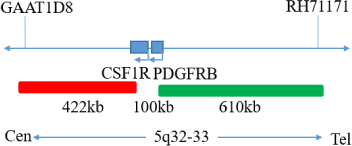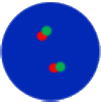Product Name
CSF1R(5q32) gene break apart probe reagent
Package Specifications
10 Tests/box
Intended use
The reagent carries out in situ hybridization staining on the basis of routine staining to provide doctors with auxiliary information for diagnosis. The test results are only for clinical reference and should not be used as the only basis for clinical diagnosis. Clinicians should comprehensively judge the test results in combination with the patient’s condition, drug indications, treatment response and other laboratory test indicators.
Detection principle
Fluorescence in situ hybridization is a technique for directly observing specific nucleic acids in cells. According to the principle of base complementary pairing, the specific probe is complementary to the target sequence in the cell. Due to the fluorescence of the probe,the gene state of the hybrid probe and the target sequence can be clearly observed under the fluorescence microscope under the appropriate excitation light.
Product Composition
The kit consists of CSF1R dual-color probes, as shown in Table 1.

Storage conditions & Validity
Keep sealed away from light at -20oC±5oC. The product is valid for 12 months. Avoid unnecessary repeated freezing and thawing that should not exceed 10 times. After opening, within 24 hours for short-term preservation, keep sealed at 2-8oC in dark. For long-term preservation after opening, keep the lid sealed at -20oC±5oC away from light. The kit is transported below 0oC.
Applicable Instruments
Fluorescence microscopy imaging systems, including fluorescence microscopy and filter sets suitable for DAPI (367/452), Green (495/517),and Orange (547/565).
Sample Requirements
1. Sample collection: take 1-3ml of bone marrow cells anticoagulated with heparin sodium
2. Sample preservation: unfixed fresh bone marrow specimen (stored at 2-8°C for no more than 24 hours) after fixation, the cell suspension shall be stored at -20±5°C for no more than 12 months; The prepared cell slides can be stored at -20±5°C for no more than 1 month. When the sample storage temperature is too high or too low, orthe cell suspension is volatilized excessively or polluted during storage, the sample will not be used for detection.
Related Reagents
The following reagents are required for the experiment but not provided in this kit
- 20×SSC, pH 5.3±0.2
Weigh 176g of sodium chloride and 88g of sodium citrate, dissolve in 800mL of deionized water, adjust the pH to 5.3±0.2 at room temperature, and complete to 1 L with deionized water. High-pressure steam sterilization, stored at 2-8oC,the solution shelf life is of 6 months. Discard if the reagent appears cloudy (turbid) or contaminated.
- 2×SSC, pH 7.0±0.2
Take 100mL of the above 20xSSC, dilute with 800mL deionized water, mix, adjust the pH to 7.0±0.2 at room temperature, complete to 1L with deionized water, stored at 2-8oC, the shelf life is of 6 months. Discard if the reagent appears cloudy (turbid) or contaminated.
- Ethanol Solution: 70% ethanol, 85% ethanol
Dilute 700ml, 850ml of ethanol with deionized water to 1L. The shelf life is of 6 months. Discard if the reagent appears cloudy (turbid) or contaminated.
- 0.3% NP-40/0.4xSSC solution, pH 7.0-7.5
Take 0.6mL NP-40 and 4mL 20×SSC, add 150mL deionized water, mix, adjust the pH to 7.0-7.5 at room temperature, with deionized water complete to a volume of 200mL. Stored at 2-8oC, the shelf life is of 6 months. Discard if the reagent appears cloudy (turbid) or contaminated.
- Fixation solution (methanol: glacial acetic acid = 3:1)
Prepare a ready to use fixation solution by mixing thoroughly 30ml of methanol and 10ml of glacial acetic acid.
- 0.075M KClsolution
Weigh 2.8g of potassium chloride, dissolve in 400mL of deionized water and complete to 500mL with deionized water. Stored at room temperature, the solution shelf life is of 6 months. Discard if the reagent appears cloudy (turbid) or contaminated.
- Diamidinyl phenylindole (DAPI) counterstain
Use commercially available anti-quenching DAPI counterstain.
Instructions
1. Sample collection and slides preparation
- Sample collection: Take 1-3mL of anticoagulated bone marrow cell samples.
- Cell harvesting: Place 3 mL of anticoagulated peripheral blood in a 15 mL centrifuge tube, centrifuge at 500g for 5 min, carefully discard the supernatant, and resuspend about 500μL of the residue.
- Cell washing: Add 5 mL of 1×PBS buffer, mix and resuspend the cell pellet, centrifuge at 500g for 5 min, carefully discard the supernatant,and resuspend the cells with about 500μL of the residue; repeat 1 time.
- Cells hypotonicty: Add 10mL of hypotonic solution pre-warmed to 37oC and place in an water bath at 37oC for 15-20min.
- Cells pre-fixation: Pre-fix the cells by adding 1mL (10% by volume) of fixative solution to the cell suspension after the completion of hypotonic osmosis. Gently pipette, mix and centrifuge for 5 min at 500g, discard the supernatant, and resuspend about 500μL of the residue.
- Cell fixation: Slowly add 10mL of fixative solution to the cell suspension at room temperature for 10 min, centrifuge at 500g for 5 min,and resuspend the cells with about 500μL of the residue; repeat once (the cells may be fixed several times until the cells pellet is washed and cleaned).
- Cell suspension preparation: Pipet the supernatant and add the appropriate amount of fixative solution to prepare the appropriate cell suspension concentration.
- Slides preparation: Pipet 3-5μL of cell suspension drop onto the slides, put at 56oC for 30min.
2. Slides preparation
- At room temperature with 2×SSC (pH 7.0) solution, rinse the slide 2 times for 5min each time.
- Place the slides in 70% ethanol, 85% ethanol and 100% ethanol for 2min each time, dehydrate and air dry.
3. Denaturation and Hybridization
The following operations should be performed in a darkroom.
- Take the probe at room temperature for 5 minutes. Briefly centrifuge manually (do not use vortex or shaker instrument). Take 10μl droplet in the cell and drop in the hybridization zone, immediately cover 22mmx22mm glass slide area; spread evenly without bubbles the probe under the glass slide covered area and seal edges with rubber (edge sealing must be thorough to prevent dry film from affecting the test results during hybridization).
- Place the glass slide in the hybridization instrument, denature at 88°C for 2 minutes (the hybridizer should be preheated to 88oC) and hybridize at 45°C for 2 to 16 hours.
4. Washing
The following operations should be performed in a darkroom.
- Take out the hybridized glass slides, remove the rubber on the coverslip and immediately place the slides into 2xSSC for 5 seconds, and gently remove the coverslip.
- Place the glass slides in 2xSSC at room temperature.
- Remove and immerse the slides in a 0.3% NP-40/0.4×SSC solution preheated at 68°C for 2 min.
- Immerse the glass slides in deionized water at 37oC for 1min, and dry naturally in the dark.
5. Counterstaining
The following operations should be performed in a darkroom
10μl DAPI compound dye is dropped in the hybridization area of the glass slide and immediately covered. The suitable filter is selected for glass slide observation under the fluorescence microscope.
6. FISH results observation
Place the stained sections under a fluorescence microscope and the cells area is first confirmed under a low magnification objective (10x);under magnification objective (40x) a uniform cells distribution is observed; then the nucleus size uniformity, nuclear boundary integrity,DAPI staining uniformity, no nuclei overlapping, cells clear signal are observed in the high magnification objective ( 100x).
Common Signal Type Interpretation
CSF1R gene site 3 signal
CSF1R gene site 5 signal
Positive: 1 orange 1 green 1 fusion
Precautions
1. Please read this manual carefully before testing. The testing personnel shall receive professional technical training, and the signal counting personnel must be able to observe and distinguish orange and green signals.
2. When testing clinical samples, when the hybridization signal counting is difficult and the sample is not enough to repeat the retest, or the cell volume is not enough for analysis, the test will not provide the test results.
3. DAPI counterstaining agent used in this experiment has potential toxicity or carcinogenicity, so it is necessary to operate in the fume hood,wear masks and gloves to avoid direct contact.
4. All chemicals are potentially dangerous. Avoid direct contact. Used kits are clinical waste and should be properly disposed off.



